The Influence of Consumer Activism on Corporate Reputation
VerifiedAdded on 2021/06/17
|8
|2127
|23
Report
AI Summary
This report examines the multifaceted impact of consumer activism, particularly in the digital age. It defines consumer activism as actions taken by consumers to influence product delivery and protect stakeholder interests, often leveraging social media platforms like Facebook and Twitter to express opinions and organize boycotts. The report analyzes the effects of such activism on corporate performance, including reputation, productivity, and profitability, using Nestle and Apple Inc. as case studies. It explores how online campaigns can damage brand image, decrease market share, and prompt companies to address consumer grievances. The report also highlights the role of ethical considerations, CSR activities, and shareholder sensitivity in shaping consumer behavior and corporate responses. Ultimately, the report concludes that while consumer activism can negatively affect a company's reputation and financial performance, it also serves as a catalyst for corporate social responsibility and ethical improvements, influencing how organizations behave and respond to consumer concerns.

Consumer activism
0 | P a g e
0 | P a g e
Paraphrase This Document
Need a fresh take? Get an instant paraphrase of this document with our AI Paraphraser
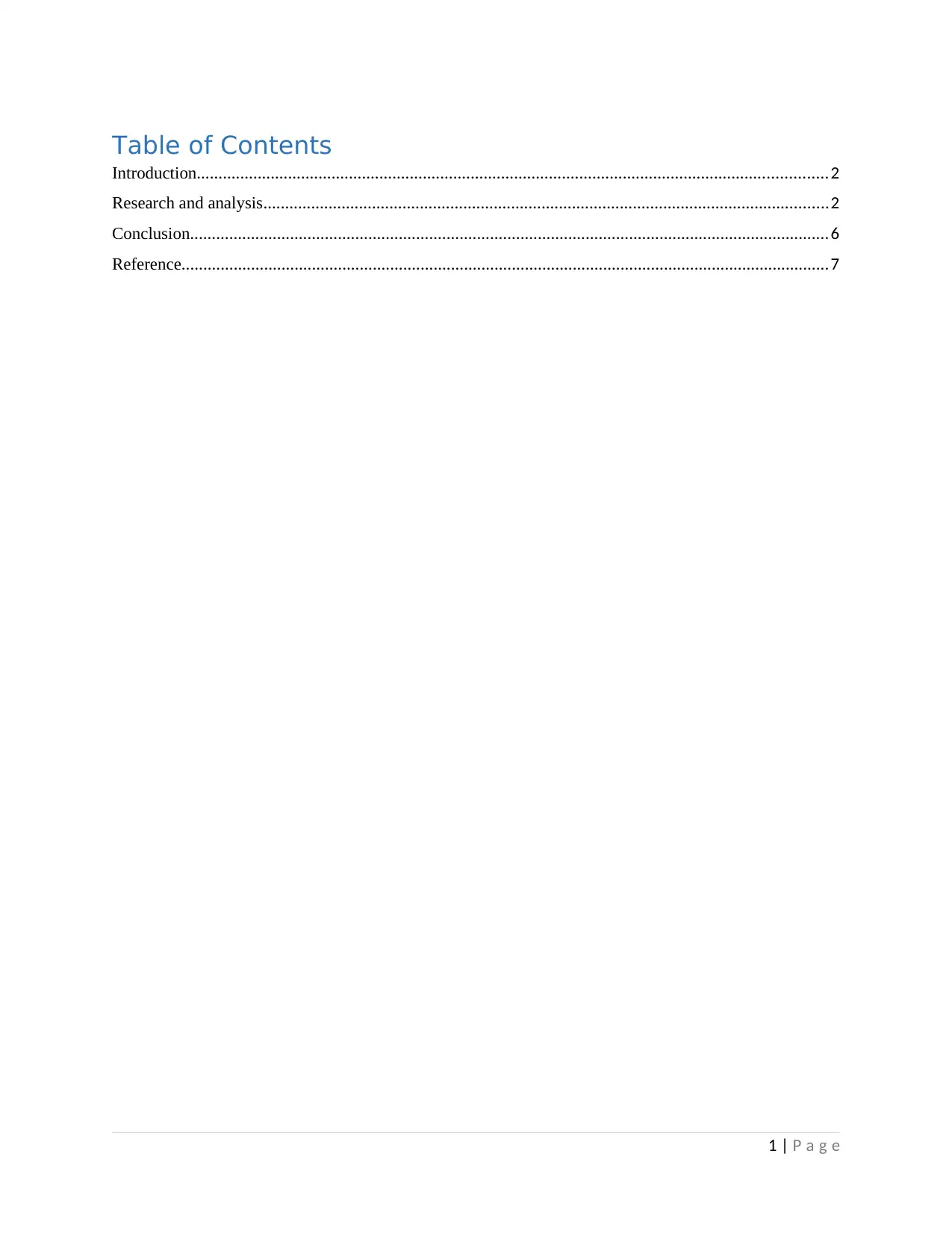
Table of Contents
Introduction.................................................................................................................................................2
Research and analysis..................................................................................................................................2
Conclusion...................................................................................................................................................6
Reference.....................................................................................................................................................7
1 | P a g e
Introduction.................................................................................................................................................2
Research and analysis..................................................................................................................................2
Conclusion...................................................................................................................................................6
Reference.....................................................................................................................................................7
1 | P a g e
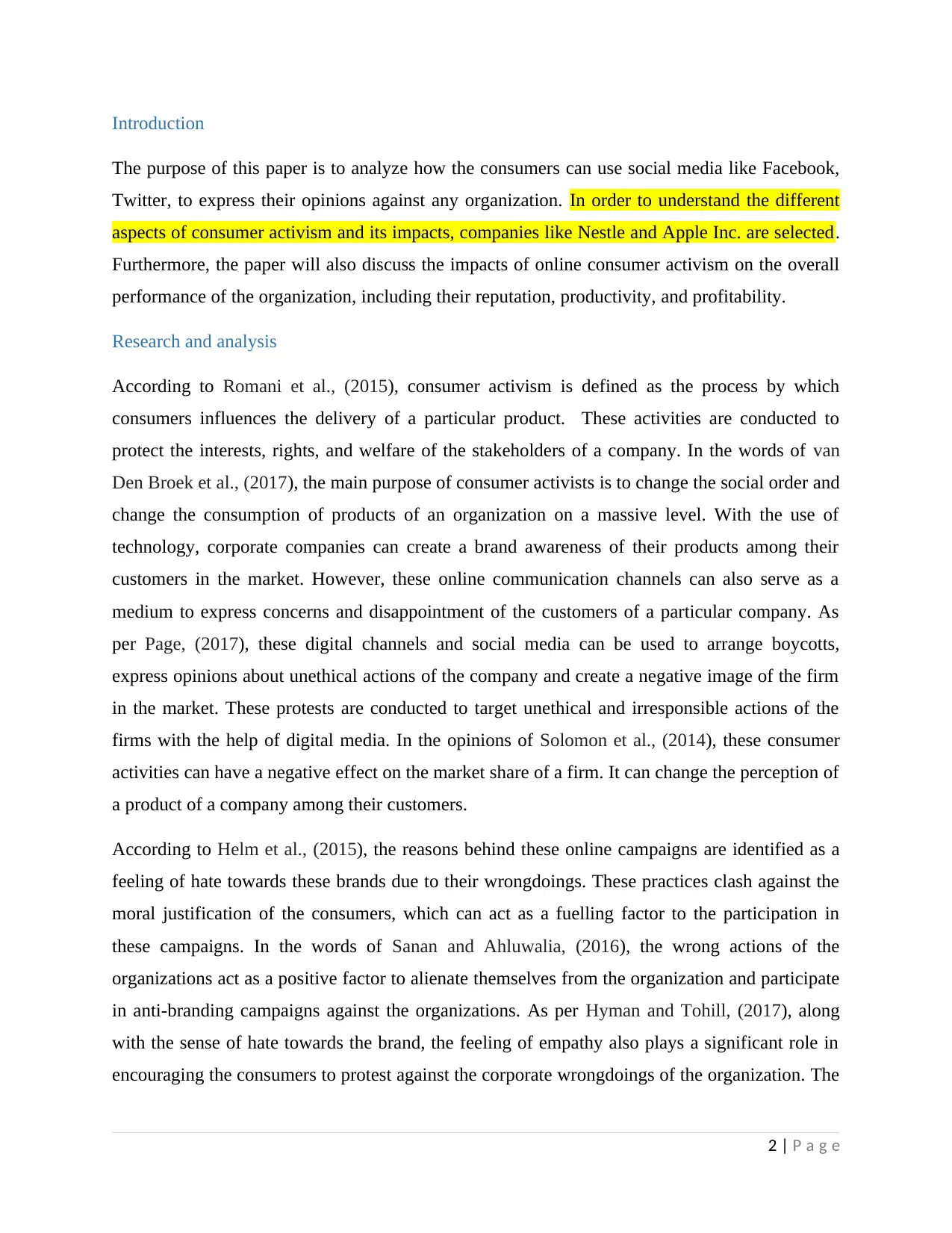
Introduction
The purpose of this paper is to analyze how the consumers can use social media like Facebook,
Twitter, to express their opinions against any organization. In order to understand the different
aspects of consumer activism and its impacts, companies like Nestle and Apple Inc. are selected.
Furthermore, the paper will also discuss the impacts of online consumer activism on the overall
performance of the organization, including their reputation, productivity, and profitability.
Research and analysis
According to Romani et al., (2015), consumer activism is defined as the process by which
consumers influences the delivery of a particular product. These activities are conducted to
protect the interests, rights, and welfare of the stakeholders of a company. In the words of van
Den Broek et al., (2017), the main purpose of consumer activists is to change the social order and
change the consumption of products of an organization on a massive level. With the use of
technology, corporate companies can create a brand awareness of their products among their
customers in the market. However, these online communication channels can also serve as a
medium to express concerns and disappointment of the customers of a particular company. As
per Page, (2017), these digital channels and social media can be used to arrange boycotts,
express opinions about unethical actions of the company and create a negative image of the firm
in the market. These protests are conducted to target unethical and irresponsible actions of the
firms with the help of digital media. In the opinions of Solomon et al., (2014), these consumer
activities can have a negative effect on the market share of a firm. It can change the perception of
a product of a company among their customers.
According to Helm et al., (2015), the reasons behind these online campaigns are identified as a
feeling of hate towards these brands due to their wrongdoings. These practices clash against the
moral justification of the consumers, which can act as a fuelling factor to the participation in
these campaigns. In the words of Sanan and Ahluwalia, (2016), the wrong actions of the
organizations act as a positive factor to alienate themselves from the organization and participate
in anti-branding campaigns against the organizations. As per Hyman and Tohill, (2017), along
with the sense of hate towards the brand, the feeling of empathy also plays a significant role in
encouraging the consumers to protest against the corporate wrongdoings of the organization. The
2 | P a g e
The purpose of this paper is to analyze how the consumers can use social media like Facebook,
Twitter, to express their opinions against any organization. In order to understand the different
aspects of consumer activism and its impacts, companies like Nestle and Apple Inc. are selected.
Furthermore, the paper will also discuss the impacts of online consumer activism on the overall
performance of the organization, including their reputation, productivity, and profitability.
Research and analysis
According to Romani et al., (2015), consumer activism is defined as the process by which
consumers influences the delivery of a particular product. These activities are conducted to
protect the interests, rights, and welfare of the stakeholders of a company. In the words of van
Den Broek et al., (2017), the main purpose of consumer activists is to change the social order and
change the consumption of products of an organization on a massive level. With the use of
technology, corporate companies can create a brand awareness of their products among their
customers in the market. However, these online communication channels can also serve as a
medium to express concerns and disappointment of the customers of a particular company. As
per Page, (2017), these digital channels and social media can be used to arrange boycotts,
express opinions about unethical actions of the company and create a negative image of the firm
in the market. These protests are conducted to target unethical and irresponsible actions of the
firms with the help of digital media. In the opinions of Solomon et al., (2014), these consumer
activities can have a negative effect on the market share of a firm. It can change the perception of
a product of a company among their customers.
According to Helm et al., (2015), the reasons behind these online campaigns are identified as a
feeling of hate towards these brands due to their wrongdoings. These practices clash against the
moral justification of the consumers, which can act as a fuelling factor to the participation in
these campaigns. In the words of Sanan and Ahluwalia, (2016), the wrong actions of the
organizations act as a positive factor to alienate themselves from the organization and participate
in anti-branding campaigns against the organizations. As per Hyman and Tohill, (2017), along
with the sense of hate towards the brand, the feeling of empathy also plays a significant role in
encouraging the consumers to protest against the corporate wrongdoings of the organization. The
2 | P a g e
⊘ This is a preview!⊘
Do you want full access?
Subscribe today to unlock all pages.

Trusted by 1+ million students worldwide

negative emotions of consumers play a vital role in decreasing the sales of an organization along
with their reputation and profitability.
In the opinions of Holden and Zlatevska, (2015), digital media is used to promote the idea of
anti-consumption of the products of the organizations. There are several incidents where online
consumer activism has affected the business volume of an organization. For example, after
finding out that palm oil used in the production of Kit Kat is responsible for destroying
rainforests of the world, Greenpeace has started a campaign against the company on social
media. As per Carroll, (2015), this movement has severely affected the business growth of the
organization and forced them to reject their deal with the palm oil supplying company. This
movement allows the consumers to express their dissatisfaction among themselves, thus
spreading the word of hate in the market. Due to this online consumerism, the reputation of
Nestle is ruined, and millions of consumers stop using their products. This activism is conducted
on social media platforms like Facebook and Twitter. The consumers started to accompany the
brand name Nestle with harmful environmental practices, ruining the business volume of the
organization. Some consumers have started an anti-branding campaign conducted against Apple
Inc. In the social media, the consumers have started a campaign against Apple to protest against
their inflated prices, lack of corporate social responsibility activities of the organization and
failure to deliver the promises of the organization. These activists also started this campaign to
protest against the arrogance of the employees of the brand. This campaign is conducted on
Facebook to create a bad image of the organization in the market. As a result, the brand
recognition of the company is ruined thus severely affecting the business of the company.
According to Gabriel and Lang, (2015), online consumer movements target people who have
similar complaints against a company and dislike their products. It is designed to highlight all the
areas of problems of the organization and its products. There are similar anti-apple campaigns
conducted on other social media platforms as well, such as Twitter and Google Plus. These
campaigns are successful to create a negative image of the company in the market, which
affected its market share and overall profitability. Social media platforms can offer a way to
organize these campaigns by exchanging information among them. In the words of, lack of CSR
activities can encourage these consumers to participate in these campaigns, which can decrease
the market share and reputation of the organizations in the market. It can also have a negative
3 | P a g e
with their reputation and profitability.
In the opinions of Holden and Zlatevska, (2015), digital media is used to promote the idea of
anti-consumption of the products of the organizations. There are several incidents where online
consumer activism has affected the business volume of an organization. For example, after
finding out that palm oil used in the production of Kit Kat is responsible for destroying
rainforests of the world, Greenpeace has started a campaign against the company on social
media. As per Carroll, (2015), this movement has severely affected the business growth of the
organization and forced them to reject their deal with the palm oil supplying company. This
movement allows the consumers to express their dissatisfaction among themselves, thus
spreading the word of hate in the market. Due to this online consumerism, the reputation of
Nestle is ruined, and millions of consumers stop using their products. This activism is conducted
on social media platforms like Facebook and Twitter. The consumers started to accompany the
brand name Nestle with harmful environmental practices, ruining the business volume of the
organization. Some consumers have started an anti-branding campaign conducted against Apple
Inc. In the social media, the consumers have started a campaign against Apple to protest against
their inflated prices, lack of corporate social responsibility activities of the organization and
failure to deliver the promises of the organization. These activists also started this campaign to
protest against the arrogance of the employees of the brand. This campaign is conducted on
Facebook to create a bad image of the organization in the market. As a result, the brand
recognition of the company is ruined thus severely affecting the business of the company.
According to Gabriel and Lang, (2015), online consumer movements target people who have
similar complaints against a company and dislike their products. It is designed to highlight all the
areas of problems of the organization and its products. There are similar anti-apple campaigns
conducted on other social media platforms as well, such as Twitter and Google Plus. These
campaigns are successful to create a negative image of the company in the market, which
affected its market share and overall profitability. Social media platforms can offer a way to
organize these campaigns by exchanging information among them. In the words of, lack of CSR
activities can encourage these consumers to participate in these campaigns, which can decrease
the market share and reputation of the organizations in the market. It can also have a negative
3 | P a g e
Paraphrase This Document
Need a fresh take? Get an instant paraphrase of this document with our AI Paraphraser
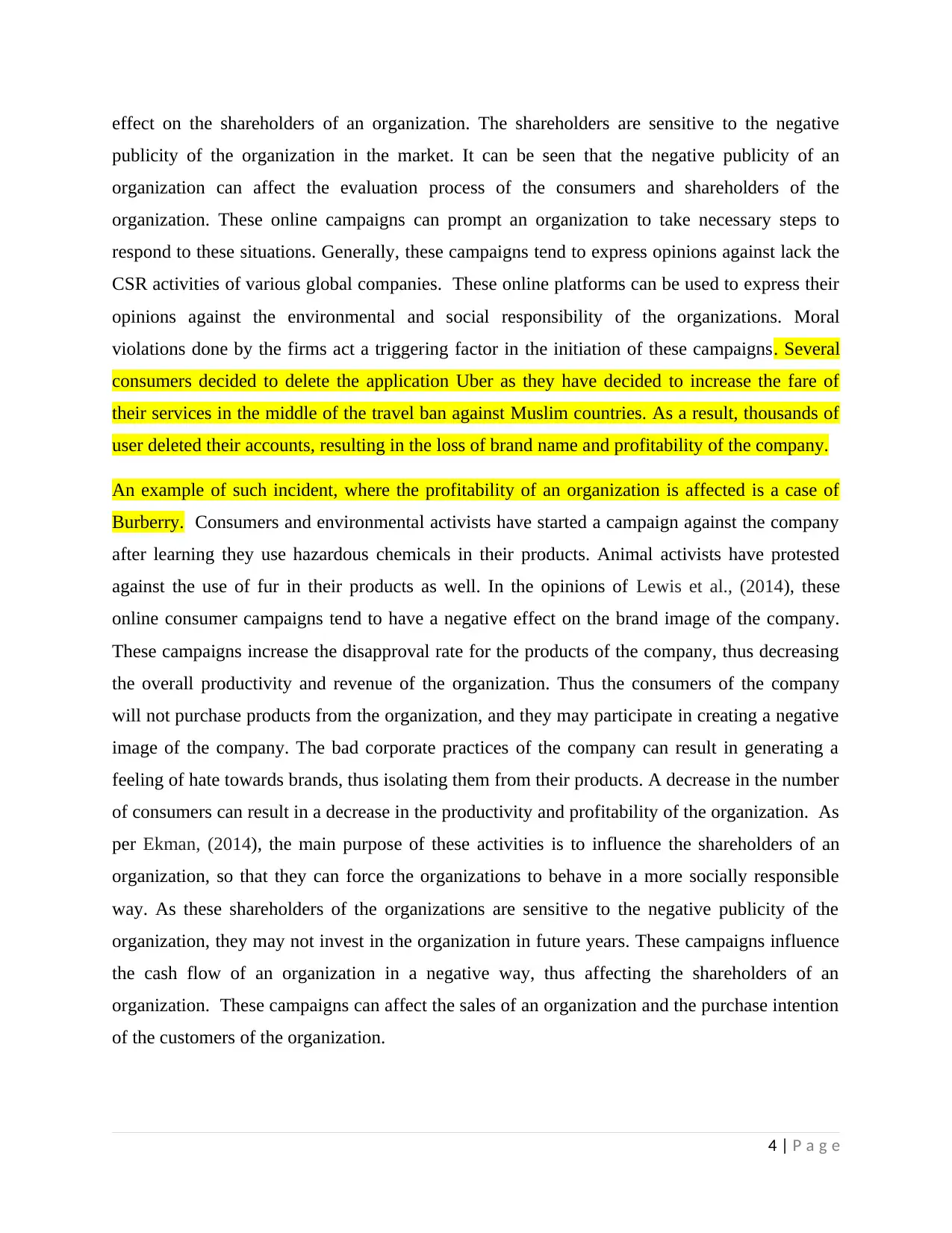
effect on the shareholders of an organization. The shareholders are sensitive to the negative
publicity of the organization in the market. It can be seen that the negative publicity of an
organization can affect the evaluation process of the consumers and shareholders of the
organization. These online campaigns can prompt an organization to take necessary steps to
respond to these situations. Generally, these campaigns tend to express opinions against lack the
CSR activities of various global companies. These online platforms can be used to express their
opinions against the environmental and social responsibility of the organizations. Moral
violations done by the firms act a triggering factor in the initiation of these campaigns. Several
consumers decided to delete the application Uber as they have decided to increase the fare of
their services in the middle of the travel ban against Muslim countries. As a result, thousands of
user deleted their accounts, resulting in the loss of brand name and profitability of the company.
An example of such incident, where the profitability of an organization is affected is a case of
Burberry. Consumers and environmental activists have started a campaign against the company
after learning they use hazardous chemicals in their products. Animal activists have protested
against the use of fur in their products as well. In the opinions of Lewis et al., (2014), these
online consumer campaigns tend to have a negative effect on the brand image of the company.
These campaigns increase the disapproval rate for the products of the company, thus decreasing
the overall productivity and revenue of the organization. Thus the consumers of the company
will not purchase products from the organization, and they may participate in creating a negative
image of the company. The bad corporate practices of the company can result in generating a
feeling of hate towards brands, thus isolating them from their products. A decrease in the number
of consumers can result in a decrease in the productivity and profitability of the organization. As
per Ekman, (2014), the main purpose of these activities is to influence the shareholders of an
organization, so that they can force the organizations to behave in a more socially responsible
way. As these shareholders of the organizations are sensitive to the negative publicity of the
organization, they may not invest in the organization in future years. These campaigns influence
the cash flow of an organization in a negative way, thus affecting the shareholders of an
organization. These campaigns can affect the sales of an organization and the purchase intention
of the customers of the organization.
4 | P a g e
publicity of the organization in the market. It can be seen that the negative publicity of an
organization can affect the evaluation process of the consumers and shareholders of the
organization. These online campaigns can prompt an organization to take necessary steps to
respond to these situations. Generally, these campaigns tend to express opinions against lack the
CSR activities of various global companies. These online platforms can be used to express their
opinions against the environmental and social responsibility of the organizations. Moral
violations done by the firms act a triggering factor in the initiation of these campaigns. Several
consumers decided to delete the application Uber as they have decided to increase the fare of
their services in the middle of the travel ban against Muslim countries. As a result, thousands of
user deleted their accounts, resulting in the loss of brand name and profitability of the company.
An example of such incident, where the profitability of an organization is affected is a case of
Burberry. Consumers and environmental activists have started a campaign against the company
after learning they use hazardous chemicals in their products. Animal activists have protested
against the use of fur in their products as well. In the opinions of Lewis et al., (2014), these
online consumer campaigns tend to have a negative effect on the brand image of the company.
These campaigns increase the disapproval rate for the products of the company, thus decreasing
the overall productivity and revenue of the organization. Thus the consumers of the company
will not purchase products from the organization, and they may participate in creating a negative
image of the company. The bad corporate practices of the company can result in generating a
feeling of hate towards brands, thus isolating them from their products. A decrease in the number
of consumers can result in a decrease in the productivity and profitability of the organization. As
per Ekman, (2014), the main purpose of these activities is to influence the shareholders of an
organization, so that they can force the organizations to behave in a more socially responsible
way. As these shareholders of the organizations are sensitive to the negative publicity of the
organization, they may not invest in the organization in future years. These campaigns influence
the cash flow of an organization in a negative way, thus affecting the shareholders of an
organization. These campaigns can affect the sales of an organization and the purchase intention
of the customers of the organization.
4 | P a g e

As per Solomon et al., (2014), these online consumer protests create a negative impact on the
brand image of the organization. As a result of these protests, the CSR rankings of an
organization can decrease as well as the value of their market shares. These protests tend to
create the significant amount of effect on the brand image of the reputed organizations. The
intensity of these protests also has a significant impact on the brand image of the company. In the
words of, despite the negative effects of online consumer protests, it has some positive sides
associated with the concept. These online protests allow the shareholders of the organizations to
learn about the irresponsible behavior of the organizations, thus prompting them to make
necessary adjustments to the corporate practices of these firms. The organizations can identify
the weak areas and try to rectify it to improve the image of the company. They can engage in a
more socially responsible behavior, thus increasing their CSR rankings in the market. They can
also increase their sales, revenue and overall profitability of the organization by implementing
some socially and environmentally responsible strategies.
5 | P a g e
brand image of the organization. As a result of these protests, the CSR rankings of an
organization can decrease as well as the value of their market shares. These protests tend to
create the significant amount of effect on the brand image of the reputed organizations. The
intensity of these protests also has a significant impact on the brand image of the company. In the
words of, despite the negative effects of online consumer protests, it has some positive sides
associated with the concept. These online protests allow the shareholders of the organizations to
learn about the irresponsible behavior of the organizations, thus prompting them to make
necessary adjustments to the corporate practices of these firms. The organizations can identify
the weak areas and try to rectify it to improve the image of the company. They can engage in a
more socially responsible behavior, thus increasing their CSR rankings in the market. They can
also increase their sales, revenue and overall profitability of the organization by implementing
some socially and environmentally responsible strategies.
5 | P a g e
⊘ This is a preview!⊘
Do you want full access?
Subscribe today to unlock all pages.

Trusted by 1+ million students worldwide
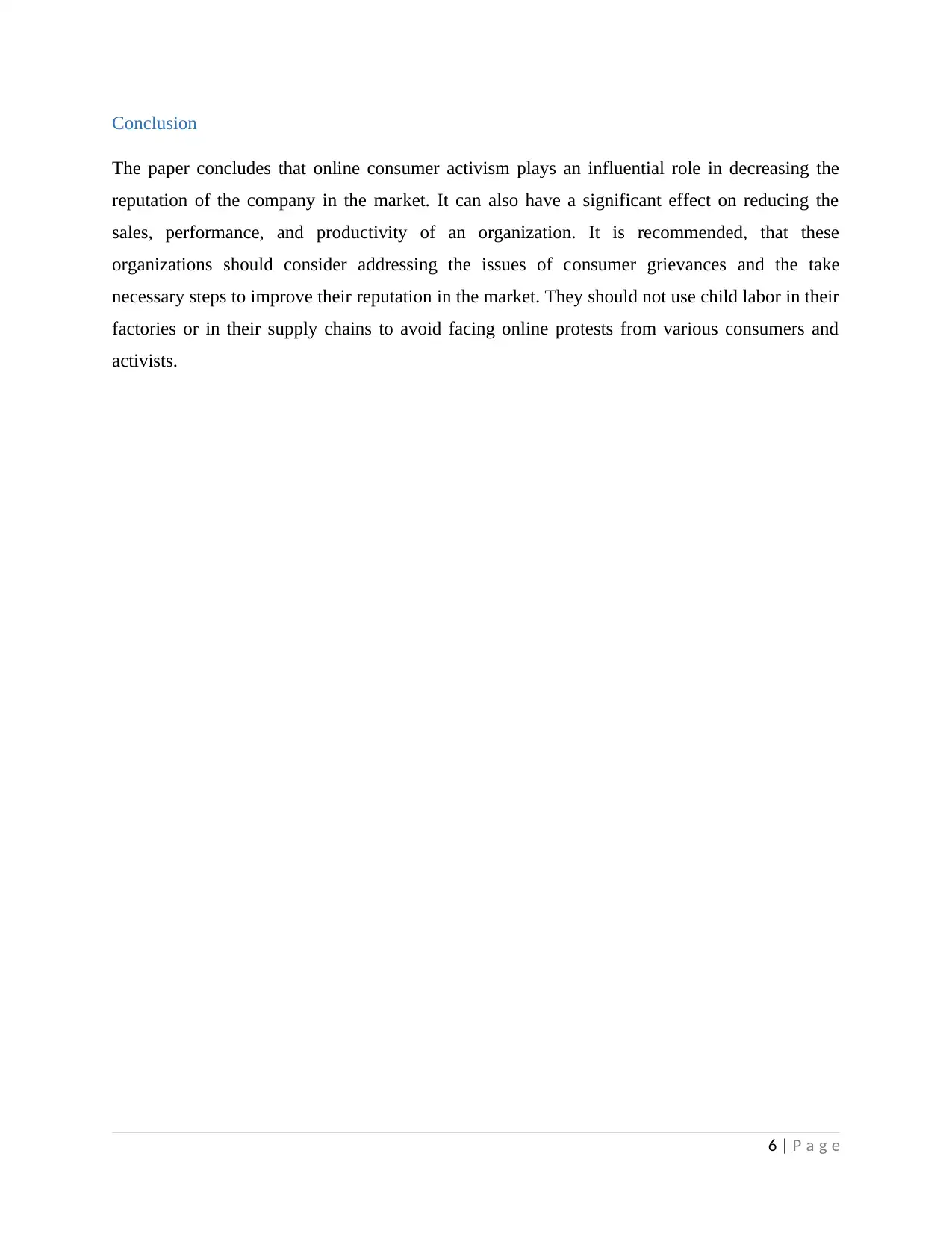
Conclusion
The paper concludes that online consumer activism plays an influential role in decreasing the
reputation of the company in the market. It can also have a significant effect on reducing the
sales, performance, and productivity of an organization. It is recommended, that these
organizations should consider addressing the issues of consumer grievances and the take
necessary steps to improve their reputation in the market. They should not use child labor in their
factories or in their supply chains to avoid facing online protests from various consumers and
activists.
6 | P a g e
The paper concludes that online consumer activism plays an influential role in decreasing the
reputation of the company in the market. It can also have a significant effect on reducing the
sales, performance, and productivity of an organization. It is recommended, that these
organizations should consider addressing the issues of consumer grievances and the take
necessary steps to improve their reputation in the market. They should not use child labor in their
factories or in their supply chains to avoid facing online protests from various consumers and
activists.
6 | P a g e
Paraphrase This Document
Need a fresh take? Get an instant paraphrase of this document with our AI Paraphraser
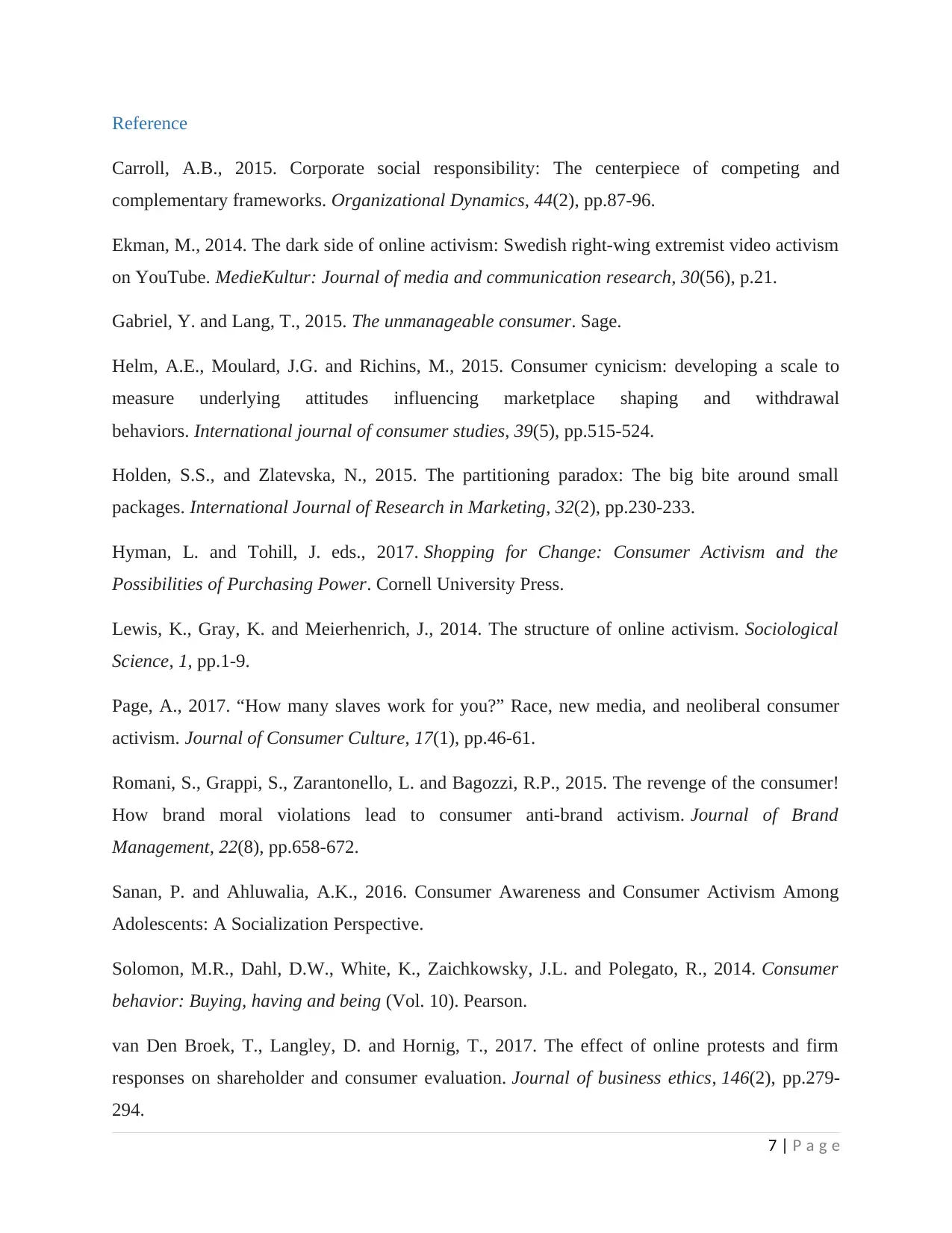
Reference
Carroll, A.B., 2015. Corporate social responsibility: The centerpiece of competing and
complementary frameworks. Organizational Dynamics, 44(2), pp.87-96.
Ekman, M., 2014. The dark side of online activism: Swedish right-wing extremist video activism
on YouTube. MedieKultur: Journal of media and communication research, 30(56), p.21.
Gabriel, Y. and Lang, T., 2015. The unmanageable consumer. Sage.
Helm, A.E., Moulard, J.G. and Richins, M., 2015. Consumer cynicism: developing a scale to
measure underlying attitudes influencing marketplace shaping and withdrawal
behaviors. International journal of consumer studies, 39(5), pp.515-524.
Holden, S.S., and Zlatevska, N., 2015. The partitioning paradox: The big bite around small
packages. International Journal of Research in Marketing, 32(2), pp.230-233.
Hyman, L. and Tohill, J. eds., 2017. Shopping for Change: Consumer Activism and the
Possibilities of Purchasing Power. Cornell University Press.
Lewis, K., Gray, K. and Meierhenrich, J., 2014. The structure of online activism. Sociological
Science, 1, pp.1-9.
Page, A., 2017. “How many slaves work for you?” Race, new media, and neoliberal consumer
activism. Journal of Consumer Culture, 17(1), pp.46-61.
Romani, S., Grappi, S., Zarantonello, L. and Bagozzi, R.P., 2015. The revenge of the consumer!
How brand moral violations lead to consumer anti-brand activism. Journal of Brand
Management, 22(8), pp.658-672.
Sanan, P. and Ahluwalia, A.K., 2016. Consumer Awareness and Consumer Activism Among
Adolescents: A Socialization Perspective.
Solomon, M.R., Dahl, D.W., White, K., Zaichkowsky, J.L. and Polegato, R., 2014. Consumer
behavior: Buying, having and being (Vol. 10). Pearson.
van Den Broek, T., Langley, D. and Hornig, T., 2017. The effect of online protests and firm
responses on shareholder and consumer evaluation. Journal of business ethics, 146(2), pp.279-
294.
7 | P a g e
Carroll, A.B., 2015. Corporate social responsibility: The centerpiece of competing and
complementary frameworks. Organizational Dynamics, 44(2), pp.87-96.
Ekman, M., 2014. The dark side of online activism: Swedish right-wing extremist video activism
on YouTube. MedieKultur: Journal of media and communication research, 30(56), p.21.
Gabriel, Y. and Lang, T., 2015. The unmanageable consumer. Sage.
Helm, A.E., Moulard, J.G. and Richins, M., 2015. Consumer cynicism: developing a scale to
measure underlying attitudes influencing marketplace shaping and withdrawal
behaviors. International journal of consumer studies, 39(5), pp.515-524.
Holden, S.S., and Zlatevska, N., 2015. The partitioning paradox: The big bite around small
packages. International Journal of Research in Marketing, 32(2), pp.230-233.
Hyman, L. and Tohill, J. eds., 2017. Shopping for Change: Consumer Activism and the
Possibilities of Purchasing Power. Cornell University Press.
Lewis, K., Gray, K. and Meierhenrich, J., 2014. The structure of online activism. Sociological
Science, 1, pp.1-9.
Page, A., 2017. “How many slaves work for you?” Race, new media, and neoliberal consumer
activism. Journal of Consumer Culture, 17(1), pp.46-61.
Romani, S., Grappi, S., Zarantonello, L. and Bagozzi, R.P., 2015. The revenge of the consumer!
How brand moral violations lead to consumer anti-brand activism. Journal of Brand
Management, 22(8), pp.658-672.
Sanan, P. and Ahluwalia, A.K., 2016. Consumer Awareness and Consumer Activism Among
Adolescents: A Socialization Perspective.
Solomon, M.R., Dahl, D.W., White, K., Zaichkowsky, J.L. and Polegato, R., 2014. Consumer
behavior: Buying, having and being (Vol. 10). Pearson.
van Den Broek, T., Langley, D. and Hornig, T., 2017. The effect of online protests and firm
responses on shareholder and consumer evaluation. Journal of business ethics, 146(2), pp.279-
294.
7 | P a g e
1 out of 8
Related Documents
Your All-in-One AI-Powered Toolkit for Academic Success.
+13062052269
info@desklib.com
Available 24*7 on WhatsApp / Email
![[object Object]](/_next/static/media/star-bottom.7253800d.svg)
Unlock your academic potential
Copyright © 2020–2025 A2Z Services. All Rights Reserved. Developed and managed by ZUCOL.




